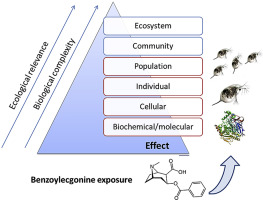Environmental Pollution ( IF 7.6 ) Pub Date : 2017-09-18 , DOI: 10.1016/j.envpol.2017.09.038 Marco Parolini , Beatrice De Felice , Claudia Ferrario , Noelia Salgueiro-González , Sara Castiglioni , Antonio Finizio , Paolo Tremolada

|
Several monitoring studies have shown that benzoylecgonine (BE) is the main illicit drug residue commonly measured in the aquatic system worldwide. Few studies have investigated the potential toxicity of this molecule towards invertebrate and vertebrate aquatic non-target organisms focusing on effects at low levels of the biological organization, but no one has assessed the consequences at higher ones. Thus, the present study was aimed at investigating the toxicity of a 48-h exposure to two concentrations of BE, similar to those found in aquatic ecosystems (0.5 μg/L and 1.0 μg/L), on the cladoceran Daphnia magna at different levels of the ecological hierarchy. We relied on a multi-level approach focusing on the effects at biochemical/biomolecular (biomarkers), individual (swimming activity) and population (reproduction) levels. We measured the amount of reactive oxygen species and of the activity of antioxidant (SOD, CAT, and GPx) and detoxifying (GST) enzymes to assess if BE exposure can alter the oxidative status of D. magna specimens, while the lipid peroxidation (TBARS) was measured as a marker of oxidative damage. Moreover, we also measured the acetylcholinesterase (AChE) activity because it is strictly related to behavioral changes in aquatic organisms. Changes in swimming behavior were investigated by a video tracking analysis, while the consequences on reproduction were assessed by a chronic toxicity test. Our results showed that BE concentrations similar to those found in aquatic ecosystems induced oxidative stress and inhibited AChE activity, affecting swimming behavior and the reproduction of Daphnia magna individuals.
中文翻译:

苯甲酰芽子碱暴露会引起水蚤的氧化应激并改变其游泳行为和繁殖
几项监测研究表明,苯甲酰基芽子碱(BE)是世界范围内水生系统中常见的主要非法药物残留。很少有研究研究这种分子对无脊椎动物和脊椎动物水生非靶标生物的潜在毒性,而这种毒性主要集中在低水平的生物组织上,但是没有人评估过较高水平的后果。因此,本研究的目的是调查48小时暴露的,要作两个浓度,类似于那些在水生生态系统(0.5微克/升和1.0微克/升)中发现的毒性,在枝角类水蚤在生态等级的不同层次上。我们依赖于多级方法,重点关注在生化/生物分子(生物标志物),个体(游泳活动)和种群(繁殖)水平上的影响。我们测量了活性氧的数量以及抗氧化剂(SOD,CAT和GPx)和解毒(GST)酶的活性,以评估BE暴露是否可以改变D. magna的氧化状态。标本,而脂质过氧化(TBARS)被测量为氧化损伤的标志。此外,我们还测量了乙酰胆碱酯酶(AChE)活性,因为它与水生生物的行为变化严格相关。通过视频跟踪分析研究了游泳行为的变化,而通过慢性毒性试验评估了对繁殖的影响。我们的结果表明,BE浓度与水生生态系统中的浓度相似,可诱导氧化应激并抑制AChE活性,影响游泳行为和水蚤的繁殖。











































 京公网安备 11010802027423号
京公网安备 11010802027423号